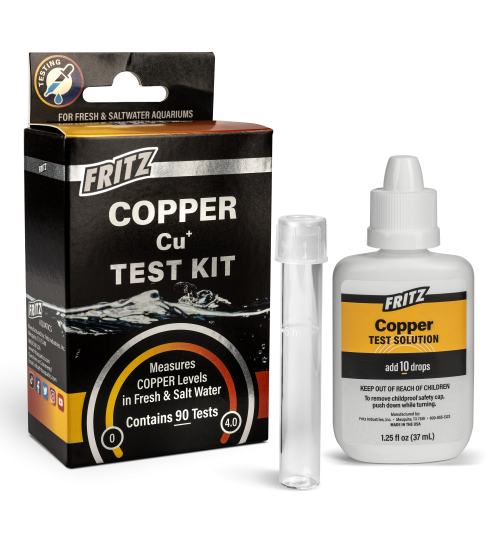About Fritz Liquid Test Kits - Copper
Copper is commonly used in aquariums to treat external parasitic infections, like Ich and velvet. It is crucial to closely monitor copper used in aquariums to ensure the correct dose has been applied, especially in volumes of water that are unknown and with copper-sensitive species. This allows the treatment to be effective against the parasites, but still safe for the fish. Some types of copper (e.g. ionic copper) requires redosing to maintain a therapeutic concentration and should be monitored regularly. Water should also be tested after treatment to confirm a zero ppm copper concentration before reintroduction of any invertebrates. Copper can also contaminate some tap water and should be avoided or treated before use in systems that contain desirable invertebrates.
Directions & Dosage
To remove childproof safety cap, push down while turning.
- Fill a clean test tube with 5 ml of water to be tested (to the line on the tube).
- Add 10 drops of Copper Reagent Solution, holding dropper bottle upside down in a completely vertical position to ensure uniformity of drops added to the water sample.
- Cap the test tube and gently shake several times to mix solution. Attention! Always use the cap. Avoid skin contact as this may affect the test results.
- Immediately read the results by matching the color of the solution against those on the Copper Test Color Chart.
To decrease copper levels, perform partial water changes and/or use copper-adsorbing resins or filter media until the copper level consistently shows zero ppm with this kit.
When using Fritz Coppersafe for external parasites, the copper level should read 1.5 to 2.0 ppm copper using this kit.
Sizes
| Size | Treats | Item Number |
|---|---|---|
| 1 pack | up to 90 tests | 04004 |
FAQs
FAQs
There aren’t any frequently asked questions for Fritz Liquid Test Kits - Copper yet. Ask yours using the Submit a Question form.
Submit a Question
Can't find what you're looking for? Ask us a new question.
Images
| Image Name | |
|---|---|
| Test Kit Copper | Download Image |
